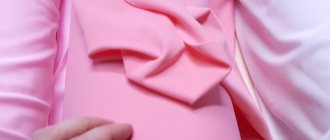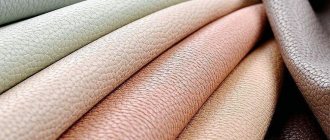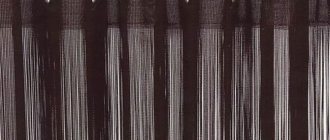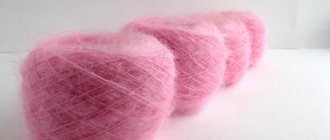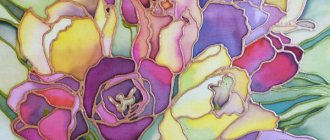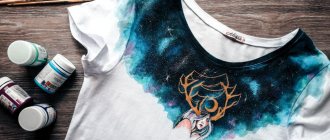People have learned to create batiks since time immemorial. This technique involves applying a design to fabric. Residents of Indonesia, India, Africa, and Japan were especially fond of art.
Women, of course, did such painstaking work. The technology for creating batik varies depending on the method of applying the design. It is better for beginners to start with simple techniques, and as their skill develops, move on to more complex options.
Types of batik
Batik experienced its heyday in the modern world in the second half of the last century. At that time this technique was extremely popular among hippies. Young people adopted the secrets of art from each other, resulting in original clothes with psychedelic patterns. Today, batik as a type of handicraft is back in fashion.
This technique can be performed in various ways:
- cold - when, before creating a pattern, a contour is applied to the fabric with a special compound;
- hot - the design is created using liquid wax, which is washed off with gasoline at the final stage;
- knotted - the fabric is first tied into knots or tied with thread, and then dipped in dye.
Sometimes painting is carried out without drawing an outline. This technique stands out as a separate type.
The most difficult thing is to create hot batik; mastery of this art does not come immediately; craftswomen master it as they gain experience. The cold method of creating batik is considered simpler. The knot technique can be considered just as simple and no less interesting. Already the first experiments using this method can please you with amazing results.
Suitable fabric for batik
Painting in the batik style is somewhat similar to creating stained glass, but instead of glass, thin fabric is used as a basis. Dense material is not suitable for these purposes, since the reserve (composition for applying the contour) will not be able to saturate thick fibers well.
As a result, the paint will flow beyond the intended area, and the design will become sloppy. All types of batik are created only on thin natural fabrics. You can use cambric, silk, double thread. For beginning painters, cambric fabric is most suitable as a base.
Batik paints
Batik paints can be purchased in a set that includes a palette of different shades. For beginners, it is better to buy dyes separately. In order to try your hand, it is enough to purchase just a few color shades. You can take different types of paints to understand which one is more convenient for you to work with.
Based on their composition, the most commonly used paints can be divided into two groups - acrylic and aniline. Dyes must be marked accordingly:
- "For batik";
- "Silk";
- "SILK".
For those who are just starting to paint on fabric, it is better to choose dyes from domestic companies whose products are inexpensive. Imported paints are more expensive, but they have a more varied palette. Such dyes stay on the fabric longer and do not weigh it down. When creating batiks, plastisol paints can also be used; after they are applied, a luminous pattern appears on the fabric.
Acrylic paints
Acrylic paints are easier to use and can be easily fixed to fabric with an iron. They are produced in cans, jars, and tubes. Acrylic is a polymer material and dries quickly in air, so brushes and palettes must be washed immediately after use; later this will be much more difficult.
Paints on this basis are unstable, they are gradually washed off from clothes during the washing process. Color acrylic pigment is also available in powder form. Before application, the crystals are thoroughly rubbed so that the coloring is uniform. Acrylic paints are best used for paintings that will later decorate the interior.
Aniline dyes
Aniline dyes are fixed only with the help of steam, so they are more suitable for experienced craftsmen. Securing designs over steam is quite difficult. At the steaming stage, an inexperienced craftswoman can easily ruin the work. At the same time, aniline-based paints have their advantages.
They are more durable and paint the material better. From the inside, the design turns out as bright as on the front side. The dye does not weigh down the fabric, unlike acrylic. For those who intend to create batiks on a regular basis, it is advisable to stock up on an autoclave, in which the steam is at a high temperature and is under pressure.
Some imported dyes are sold complete with a fixative. In this case, the process of fixing the picture is simplified. The finished product is simply rinsed in a fixing solution. If aniline is used in powder form, it must be handled with caution, as this substance is poisonous and inhaling its particles can be harmful to health.
How to make sketches for batik
Sketches for batiks are easy to create using a stencil or a simple template. Suitable pictures are simply downloaded from the Internet. Drawings can have any theme. Popular sketches include flowers, plants, abstract compositions, and portraits.
It is better to train on simple drawings; over time you will be able to move on to more complex sketches. By the way, craftsmen often take pictures for stained glass painting as a basis.
The sketch is drawn on paper without resorting to drawing small details. The size of the design should correspond to the size that needs to be obtained on the fabric. The contours of the sketch are outlined with a marker. After this, the design on the paper is attached to the fabric from the wrong side with paper tape. Through thin material, the contours will be easily visible. After this, you can proceed directly to painting on the fabric.
Cold way
Hand-painted in cold dyeing using reserve substances based on gasoline or acrylic contour on fabric is widely used in painting on silk. This technique is used to create elegant paintings or is often used to dye scarves.
Article on the topic: Openwork sweater with knitting needles: diagrams and descriptions with photos and videos
In painting silk, aniline dyes are more often used, since their structure is very light, and in painting cotton, you can use acrylic paints, which create a film. In any case, there are all kinds of fabric paints on sale, and the instructions always indicate what types of textiles they are designed for, as well as how the paint should be fixed.
Let's take a look at a visual master class on painting silk with paints. In this example, a stole on a marine theme is being painted.
The work is performed with aniline dyes using salt secretions. You will learn about it at the end of the work.
For a full-fledged stole we need the following materials and tools:
- Sketch of a drawing on paper;
- A piece of natural silk measuring 150*50cm;
- The reserve composition is black;
- Aniline dyes for batik;
- Brushes;
- Glass tube for reserve;
- Salt;
- Subframe made of wooden sticks;
- Buttons.
First of all, we pull the wet fabric tightly onto the frame using buttons. Fill the syringe with the reserve liquid until the ball is full. We apply the outline in reserve onto a dry canvas, placing a pattern template underneath.
The lines of the composition must be closed so that the paint does not escape beyond the boundaries through cracks. And she will do it very quickly and irrevocably if we leave her the move.
The lines should dry out a little, now we take our brushes and start working on the colors. Filling the cavities. The skills from childhood, when we painted coloring books, will come in handy, only the reserve contour will prevent the paint from spreading.
Several techniques for artistic painting on fabric, also applicable in this work:
- Paints can be diluted with water and mixed for specific shades and color saturation;
- Inside the “islands” it is allowed to use several colors for a smooth color transition;
- We drip the saline solution onto the background of the scarf to create beautiful water drops.
Related article: Cozy DIY candlestick from a jar
Consolidation of the result. Aniline dyes need to be steamed at the end of work. But before that, wait a day, then remove the work from the frame, wrap it in newsprint or tracing paper, and hang it in some large container, bucket or pan. Tie the bundle onto a stick longer than the diameter of the container, pour in a small amount of water, and cover it all with a thick towel. Covering with a cloth is also important so that condensation does not drip into the lids of the product, since moisture should not get on the painted silk.
You need to evaporate the work for about 40 minutes to an hour and a half. Then you will need to iron the fabric with an iron and wash it with soap at a water temperature of up to 40 degrees.
Batik is an artistic art, but its application is very wide, ranging from individual creation of a thing with your own hands. Modern clothing designers use hand-painted fabrics in pursuit of exclusivity in their collections. Photo for inspiration:
Cold batik - execution technique
Hand painting on fabric requires patience in any case. At first, the drawing will take a lot of time. With the arrival of experience, acceleration will appear. It is better to do work in a well-ventilated area, since the reserve substance used to apply the contour releases substances that are harmful to the body. It's better to start with a small drawing.
Step by step technique:
- The fabric must be secured using an embroidery hoop to prevent it from sagging. To complete large format work you will need a special frame. In this case, the fabric is secured with special hooks included in the kit.
- Nearby are pre-prepared paints, a reserve substance and a glass tube for it. If the circuit is enclosed in a tube with a tip, a tube will not be needed.
- A paper sketch is placed under the material and secured at the bottom.
- Using a soft pencil, transfer the design onto the fabric.
- The designated contours are outlined with a reserve. It is convenient to draw the reserve substance into the tube using a syringe, placing it on the opposite end of the tube. The pear contracts and the reserve enters the tube.
- After the outline has dried, check it by running a damp brush over the fabric. It is necessary to ensure that the water does not cross the contour line.
- In those places where the contour turned out to be weak, it is repeated.
- Now you can start coloring the picture with paints.
After finishing the work, the batik is removed from the frame and the design is fixed with an iron. The temperature regulator must be set to the type of fabric. Each section of the pattern is ironed for 3-5 minutes. It is better to paint in a work coat or old clothes so as not to get stained with paint.
Specifics of the cold batik technique
Cold batik technology allows you to paint different areas of the fabric in any order. Due to the fact that the reserve divides the painting into fragments, the number of colors used and the options for their combinations are not limited.
pixabay.com
This type of painting is used for clothing, interior decoration, and creating accessories. Fabrics painted using this technique are softer to the touch than those painted using the hot batik technique.
Cold batik does not have such a rich history of appearance and development as hot batik, but it is very convenient and is very popular among both beginners and professional artists.
Features of painting on silk
Silk painting is suitable for more experienced craftswomen, because it is an expensive material that would be a shame to ruin. In this case, to create batik you will need paints designed specifically for silk. For a beginner, ready-made kits with a contour and pattern already applied to the fabric are suitable. The needlewoman will only have to paint the work like a child’s coloring book.
For those who have artistic skills, the free-style painting style is suitable. In this case, you will not need a pre-created template. During work, the craftswoman will be able to better demonstrate her creativity. In addition to silk paints you will need:
- round squirrel brushes;
- water tank;
- cloth napkin for brushes;
- cotton swabs;
- colored outlines;
- palette.
Having prepared everything you need, they begin to create the picture. This can be done either cold or hot. In the second case, you will additionally need melted wax. It is applied instead of a reserve substance using a thin brush or dripping through a tube.
After the wax outline has dried, painting begins. Landscapes made using the batik technique on silk turn out very bright and impressive. Even if only one flower is painted in the picture, it will look very elegant. Silk painting is often used to decorate the interior, placing the canvases in frames and hanging them on the wall.
The procedure for making cold batik:
To prevent the pattern from shifting, secure the fabric to the template with pins.
Using a pencil, draw the outline of the design from a pre-prepared template onto the fabric.
We secure the fabric with threads or pins to the frame or insert it into a hoop. The fabric should be stretched over the frame like a drum. In this case, there is more guarantee to apply an even backup line. Before applying reserve to fabric, you should practice on a scrap piece of fabric. Make a few test lines on a piece of fabric that is the same quality as the one you are going to work on. Wait for it to dry and check for penetration. The required amount of the reserve composition is sucked into the tube with a pear (the jar should then be tightly closed). We apply the reserve onto the fabric, touching the surface with the end of the tube. The reserve should be applied evenly, the contour should be closed, otherwise the paint will spread across the fabric in shapeless spots. Draw the lines along the contour of the pencil smoothly without stopping so that the reserve compound can soak through the fabric.
After complete application of the reserve composition, the fabric should be air-dried until it is completely dry (at least 40-50 minutes). After the composition has dried, you should ensure the integrity and reliability of the circuit. Dilute 1-2 drops of shampoo or liquid soap in a small amount of water. Dip the brush into the solution and apply to individual areas of fabric enclosed by a contour. If water leaks beyond the boundaries of the circuit after a couple of minutes, then the reserve compound was applied carelessly. In this case, you need to mark the places of violations with a pencil, dry the fabric (you can use a hairdryer) and apply the reserve compound again, but better from the inside of the fabric. The remaining reserve must be removed from the glass tube, and the tube must be thoroughly rinsed with white spirit or gasoline.
Once again, having made sure of the reliability of the reserve composition, you can begin painting. Paints for painting fabric can be used either concentrated or diluted with water (see manufacturer's instructions). If paint of the required color is not available, it can be obtained by mixing paints with each other in certain proportions, selected experimentally. The paint should be mixed before use.
Diluted dye solutions are applied to the fabric with a brush or cotton balls wound on a wooden stick. First, paint over the light elements of the picture, and then its darker parts.
Dyeing solutions spread easily over the fabric.
When painting large surfaces, it is recommended to evenly wipe the entire wet surface with a piece of cotton wool. After the pattern is applied, leave the work to dry completely in a ventilated area.
After complete drying, remove the batik from the frame. Then you can use your creation, for example, frame it and hang it on the wall. If you plan to wear batik or use it around the house, then its dye should be fixed and the fabric should be steamed.
Knot batik technique
The process of creating knotted batik is always a mystery. It's difficult to predict exactly what the finished drawing will look like. Even if you perform two jobs using the same technique, they will still differ from each other. This technique is often chosen by advanced masters. It’s easier for them to predict in advance how the painting will turn out.
During the work, the fabric is not only tied with a knot in several places, but also twisted. For the first time, you can create batik according to a sample by watching the corresponding video. In the future, there is usually a desire to experiment. To begin with, it is better to master the technique on not too expensive fabric, taking scraps of cambric or thin cotton.
What a beginner should consider when creating knotted batik:
- It is desirable that the fabric be light and plain.
- You will also need strong cotton threads for this work. They will play the role of a reserve, preventing paint from leaking to the neighboring area.
- In the middle of the napkin you need to mark the center and, holding it, make a cone out of the fabric.
- Then the material is pulled in several places with thread.
- You can fold the fabric differently - like an accordion.
- The threads should pull the fabric very tightly.
- The tied napkins are dyed using the immersion method.
Then the dye solution is allowed to drain, and the napkin is rinsed in a weak shampoo solution to remove paint that has not been absorbed. When using acrylic dyes, after drying, the workpiece is ironed to fix it.
The batik technique is very popular today as a hobby. Some needlewomen are seriously interested in painting on fabric and even begin to create products for sale. In the field of handicrafts, all professionals once started with a hobby, managing over time to become a real master of their craft, who embodies creative ideas, develops their own techniques, and constantly comes up with something new, without stopping there.
Manufacturing technology
In the modern world, handmade products are increasingly attracting attention. Mass-produced clothing is now sold at every turn, and truly sophisticated and spectacular wardrobe items are difficult to find .
The techniques for making original scarves, hats, blouses and dresses are very different: they are sewn, knitted, embroidered and felted from wool. These are labor-intensive processes that require a lot of work. Batik is more convenient in this regard, because painting the fabric does not take much time. The main thing is to have all the necessary tools and imagination.
The main material for working in the batik technique is “reserve” - a special solution that is applied to the fabric and does not allow paint to pass through. These unpainted areas form a pattern that gives a piece of clothing or interior design a special shine and originality. Wax and paraffin are most often used as a reserve.
The method of dyeing and the choice of tools depends on the type of fabric. For cotton fabrics, a hot technique is used, and for more delicate materials (for example, silk) a cold technique is used.
